technical data SKODA ROOMSTER 2011 1.G Owner's Guide
[x] Cancel search | Manufacturer: SKODA, Model Year: 2011, Model line: ROOMSTER, Model: SKODA ROOMSTER 2011 1.GPages: 212, PDF Size: 3.3 MB
Page 61 of 212
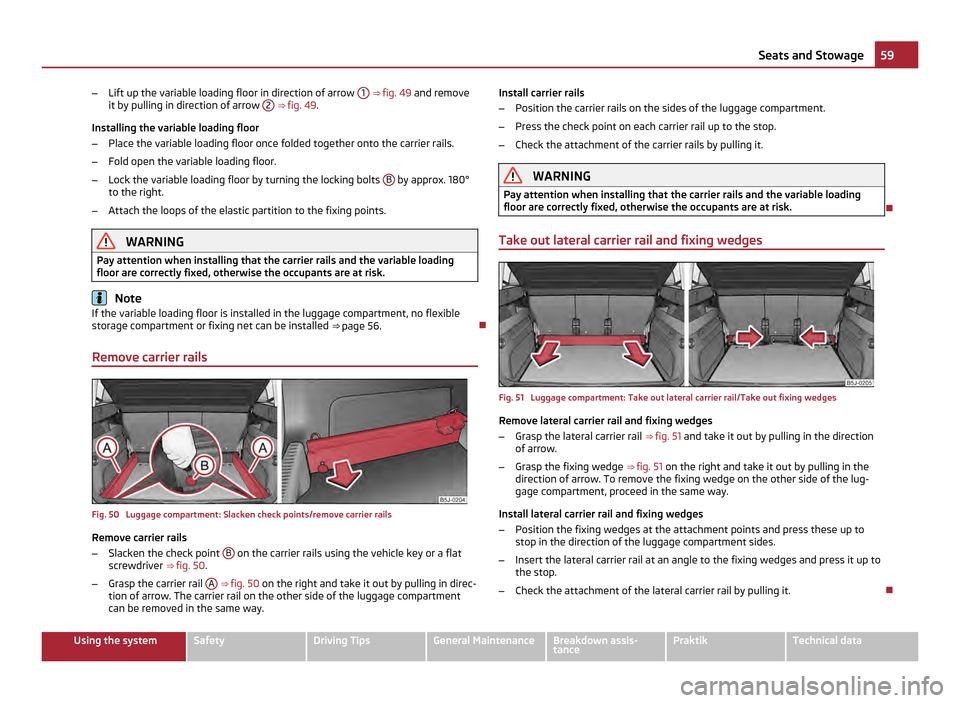
–
Lift up the variable loading floor in direction of arrow 1 ⇒ fig. 49
and remove
it by pulling in direction of arrow 2 ⇒
fig. 49 .
Installing the variable loading floor
– Place the variable loading floor once folded together onto the carrier rails.
– Fold open the variable loading floor.
– Lock the variable loading floor by turning the locking bolts B by approx. 180°
to the right.
– Attach the loops of the elastic partition to the fixing points. WARNING
Pay attention when installing that the carrier rails and the variable loading
floor are correctly fixed, otherwise the occupants are at risk. Note
If the variable loading floor is installed in the luggage compartment, no flexible
storage compartment or fixing net can be installed ⇒
page 56.
Remove carrier rails Fig. 50 Luggage compartment: Slacken check points/remove carrier rails
Remove carrier rails
–
Slacken the check point B on the carrier rails using the vehicle key or a flat
screwdriver ⇒
fig. 50 .
– Grasp the carrier rail A
⇒
fig. 50 on the right and take it out by pulling in direc-
tion of arrow. The carrier rail on the other side of the luggage compartment
can be removed in the same way. Install carrier rails
–
Position the carrier rails on the sides of the luggage compartment.
– Press the check point on each carrier rail up to the stop.
– Check the attachment of the carrier rails by pulling it. WARNING
Pay attention when installing that the carrier rails and the variable loading
floor are correctly fixed, otherwise the occupants are at risk.
Take out lateral carrier rail and fixing wedges Fig. 51 Luggage compartment: Take out lateral carrier rail/Take out fixing wedges
Remove lateral carrier rail and fixing wedges
–
Grasp the lateral carrier rail ⇒ fig. 51 and take it out by pulling in the direction
of arrow.
– Grasp the fixing wedge ⇒ fig. 51
on the right and take it out by pulling in the
direction of arrow. To remove the fixing wedge on the other side of the lug-
gage compartment, proceed in the same way.
Install lateral carrier rail and fixing wedges
– Position the fixing wedges at the attachment points and press these up to
stop in the direction of the luggage compartment sides.
– Insert the lateral carrier rail at an angle to the fixing wedges and press it up to
the stop.
– Check the attachment of the lateral carrier rail by pulling it. 59
Seats and Stowage Using the system Safety Driving Tips General Maintenance Breakdown assis-
tance Praktik Technical data
Page 63 of 212
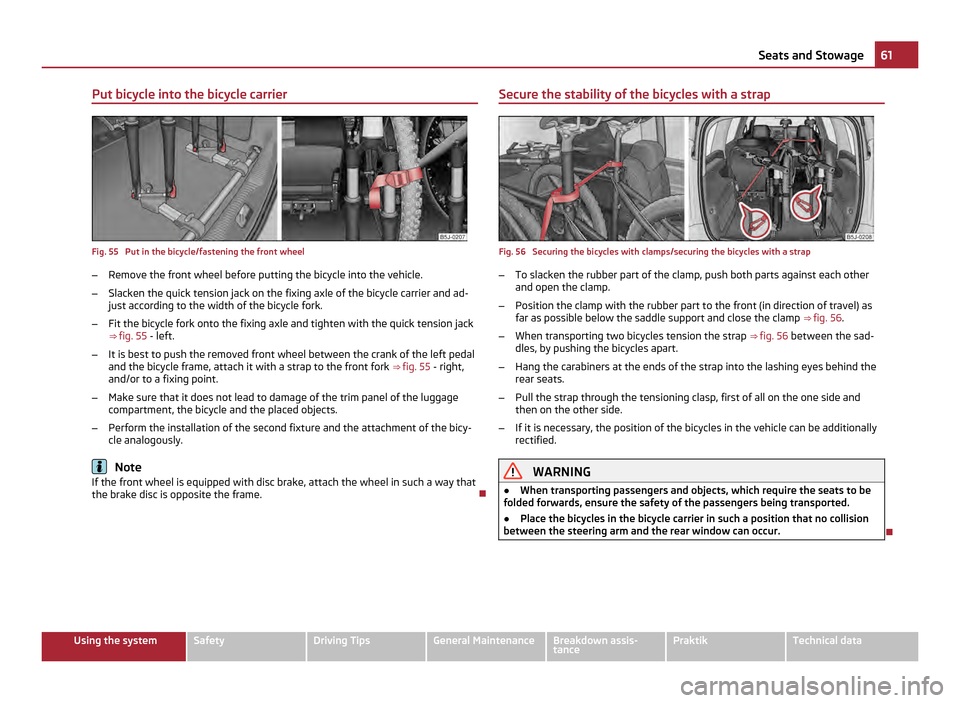
Put bicycle into the bicycle carrier
Fig. 55 Put in the bicycle/fastening the front wheel
– Remove the front wheel before putting the bicycle into the vehicle.
– Slacken the quick tension jack on the fixing axle of the bicycle carrier and ad-
just according to the width of the bicycle fork.
– Fit the bicycle fork onto the fixing axle and tighten with the quick tension jack
⇒ fig. 55 - left.
– It is best to push the removed front wheel between the crank of the left pedal
and the bicycle frame, attach it with a strap to the front fork ⇒
fig. 55 - right,
and/or to a fixing point.
– Make sure that it does not lead to damage of the trim panel of the luggage
compartment, the bicycle and the placed objects.
– Perform the installation of the second fixture and the attachment of the bicy-
cle analogously. Note
If the front wheel is equipped with disc brake, attach the wheel in such a way that
the brake disc is opposite the frame. Secure the stability of the bicycles with a strap Fig. 56 Securing the bicycles with clamps/securing the bicycles with a strap
–
To slacken the rubber part of the clamp, push both parts against each other
and open the clamp.
– Position the clamp with the rubber part to the front (in direction of travel) as
far as possible below the saddle support and close the clamp ⇒ fig. 56 .
– When transporting two bicycles tension the strap ⇒
fig. 56 between the sad-
dles, by pushing the bicycles apart.
– Hang the carabiners at the ends of the strap into the lashing eyes behind the
rear seats.
– Pull the strap through the tensioning clasp, first of all on the one side and
then on the other side.
– If it is necessary, the position of the bicycles in the vehicle can be additionally
rectified. WARNING
● When transporting passengers and objects, which require the seats to be
folded forwards, ensure the safety of the passengers being transported.
● Place the bicycles in the bicycle carrier in such a position that no collision
between the steering arm and the rear window can occur. 61
Seats and Stowage Using the system Safety Driving Tips General Maintenance Breakdown assis-
tance Praktik Technical data
Page 65 of 212
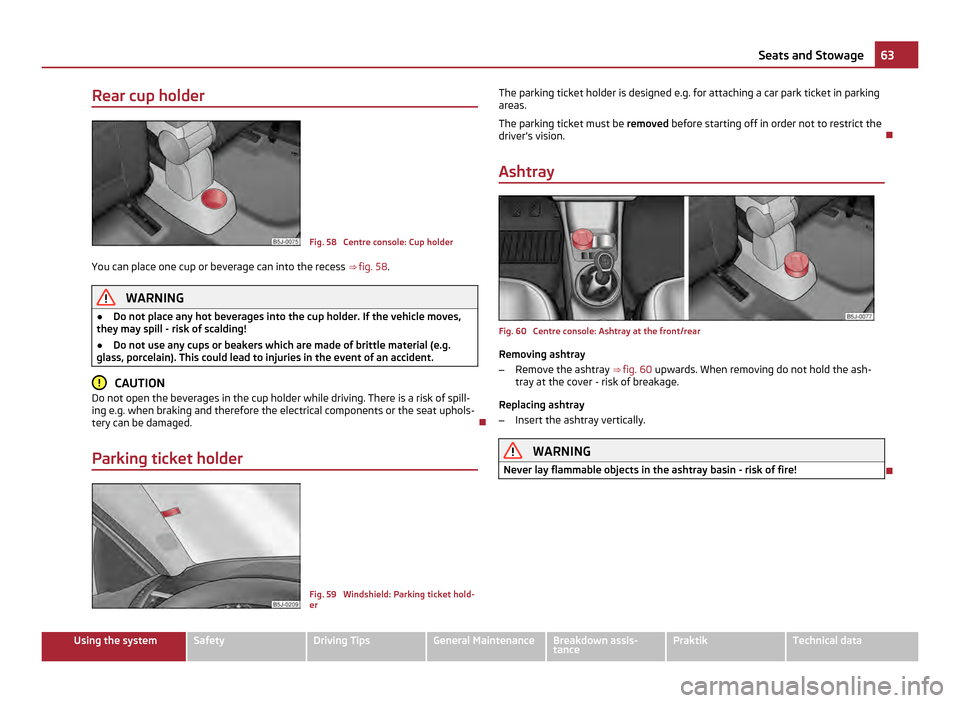
Rear cup holder
Fig. 58 Centre console: Cup holder
You can place one cup or beverage can into the recess ⇒ fig. 58 . WARNING
● Do not place any hot beverages into the cup holder. If the vehicle moves,
they may spill - risk of scalding!
● Do not use any cups or beakers which are made of brittle material (e.g.
glass, porcelain). This could lead to injuries in the event of an accident. CAUTION
Do not open the beverages in the cup holder while driving. There is a risk of spill-
ing e.g. when braking and therefore the electrical components or the seat uphols-
tery can be damaged.
Parking ticket holder Fig. 59 Windshield: Parking ticket hold-
erThe parking ticket holder is designed e.g. for attaching a car park ticket in parking
areas.
The parking ticket must be
removed before starting off in order not to restrict the
driver's vision.
Ashtray Fig. 60 Centre console: Ashtray at the front/rear
Removing ashtray
–
Remove the ashtray ⇒ fig. 60 upwards. When removing do not hold the ash-
tray at the cover - risk of breakage.
Replacing ashtray
– Insert the ashtray vertically. WARNING
Never lay flammable objects in the ashtray basin - risk of fire! 63
Seats and Stowage Using the system Safety Driving Tips General Maintenance Breakdown assis-
tance Praktik Technical data
Page 67 of 212
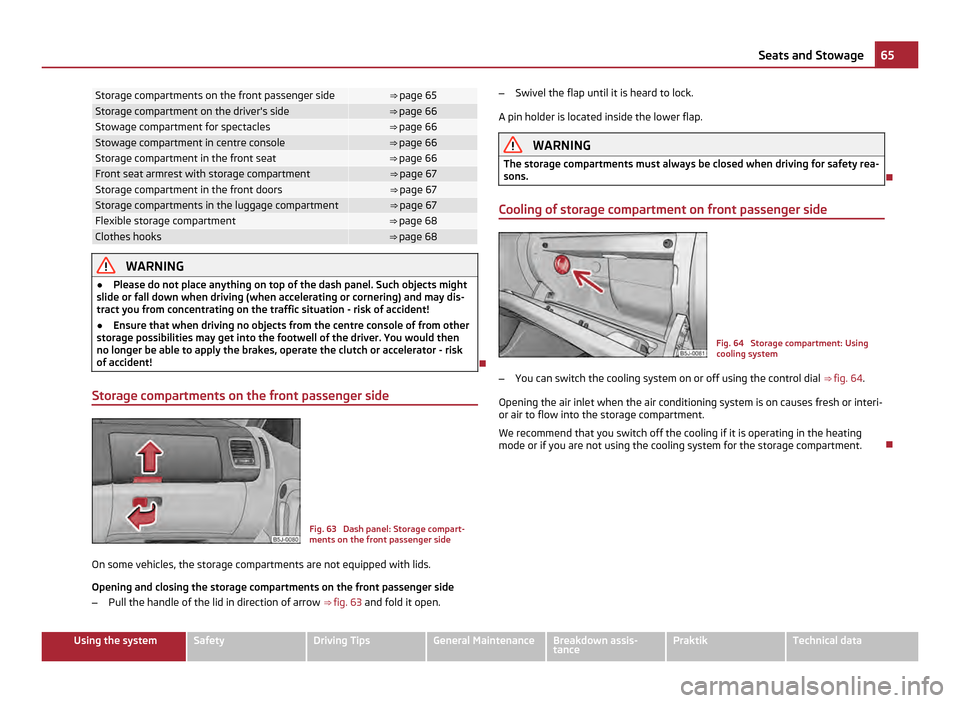
Storage compartments on the front passenger side ⇒ page 65
Storage compartment on the driver's side ⇒ page 66
Stowage compartment for spectacles ⇒ page 66
Stowage compartment in centre console ⇒ page 66
Storage compartment in the front seat ⇒ page 66
Front seat armrest with storage compartment ⇒ page 67
Storage compartment in the front doors ⇒ page 67
Storage compartments in the luggage compartment ⇒ page 67
Flexible storage compartment ⇒ page 68
Clothes hooks ⇒ page 68
WARNING
● Please do not place anything on top of the dash panel. Such objects might
slide or fall down when driving (when accelerating or cornering) and may dis-
tract you from concentrating on the traffic situation - risk of accident!
● Ensure that when driving no objects from the centre console of from other
storage possibilities may get into the footwell of the driver. You would then
no longer be able to apply the brakes, operate the clutch or accelerator - risk
of accident!
Storage compartments on the front passenger side Fig. 63 Dash panel: Storage compart-
ments on the front passenger side
On some vehicles, the storage compartments are not equipped with lids.
Opening and closing the storage compartments on the front passenger side
– Pull the handle of the lid in direction of arrow ⇒ fig. 63 and fold it open. –
Swivel the flap until it is heard to lock.
A pin holder is located inside the lower flap. WARNING
The storage compartments must always be closed when driving for safety rea-
sons.
Cooling of storage compartment on front passenger side Fig. 64 Storage compartment: Using
cooling system
– You can switch the cooling system on or off using the control dial ⇒ fig. 64 .
Opening the air inlet when the air conditioning system is on causes fresh or interi-
or air to flow into the storage compartment.
We recommend that you switch off the cooling if it is operating in the heating
mode or if you are not using the cooling system for the storage compartment. 65
Seats and Stowage Using the system Safety Driving Tips General Maintenance Breakdown assis-
tance Praktik Technical data
Page 69 of 212
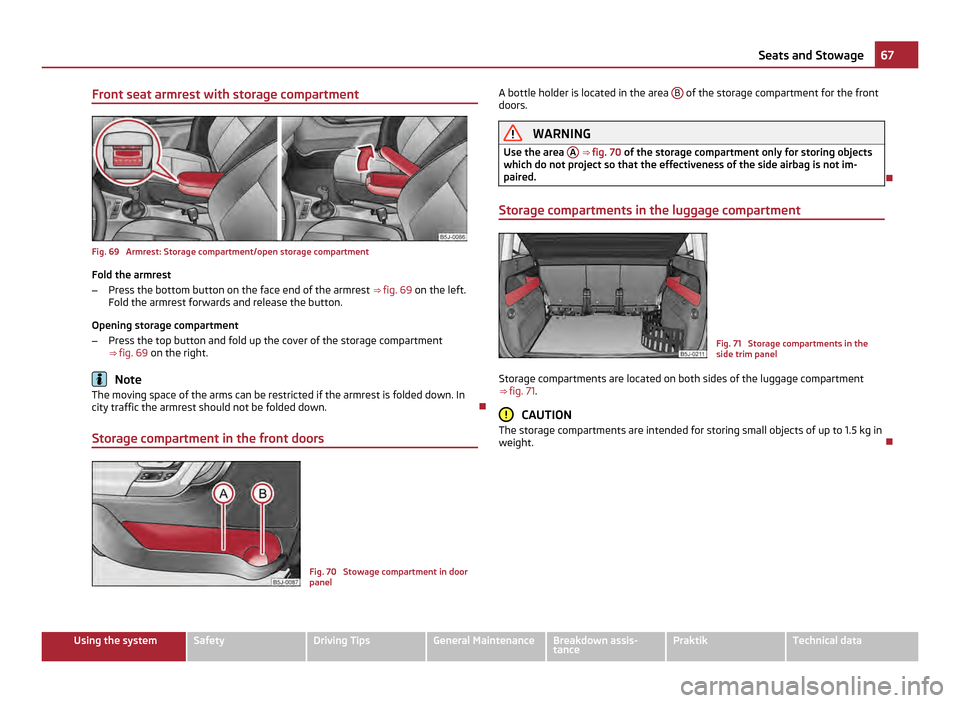
Front seat armrest with storage compartment
Fig. 69 Armrest: Storage compartment/open storage compartment
Fold the armrest
– Press the bottom button on the face end of the armrest ⇒ fig. 69 on the left.
Fold the armrest forwards and release the button.
Opening storage compartment
– Press the top button and fold up the cover of the storage compartment
⇒ fig. 69 on the right. Note
The moving space of the arms can be restricted if the armrest is folded down. In
city traffic the armrest should not be folded down.
Storage compartment in the front doors Fig. 70 Stowage compartment in door
panelA bottle holder is located in the area
B of the storage compartment for the front
doors. WARNING
Use the area A ⇒ fig. 70
of the storage compartment only for storing objects
which do not project so that the effectiveness of the side airbag is not im-
paired.
Storage compartments in the luggage compartment Fig. 71 Storage compartments in the
side trim panel
Storage compartments are located on both sides of the luggage compartment
⇒ fig. 71. CAUTION
The storage compartments are intended for storing small objects of up to 1.5 kg in
weight. 67
Seats and Stowage Using the system Safety Driving Tips General Maintenance Breakdown assis-
tance Praktik Technical data
Page 71 of 212
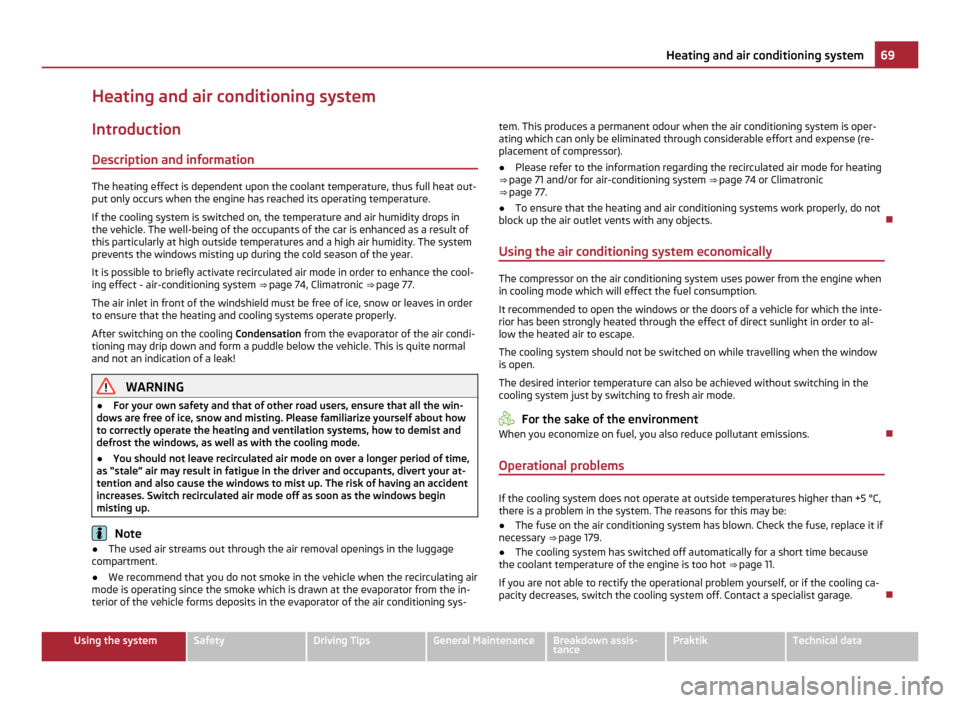
Heating and air conditioning system
Introduction
Description and information The heating effect is dependent upon the coolant temperature, thus full heat out-
put only occurs when the engine has reached its operating temperature.
If the cooling system is switched on, the temperature and air humidity drops in
the vehicle. The well-being of the occupants of the car is enhanced as a result of
this particularly at high outside temperatures and a high air humidity. The system
prevents the windows misting up during the cold season of the year.
It is possible to briefly activate recirculated air mode in order to enhance the cool-
ing effect - air-conditioning system ⇒
page 74, Climatronic ⇒ page 77.
The air inlet in front of the windshield must be free of ice, snow or leaves in order
to ensure that the heating and cooling systems operate properly.
After switching on the cooling Condensation from the evaporator of the air condi-
tioning may drip down and form a puddle below the vehicle. This is quite normal
and not an indication of a leak! WARNING
● For your own safety and that of other road users, ensure that all the win-
dows are free of ice, snow and misting. Please familiarize yourself about how
to correctly operate the heating and ventilation systems, how to demist and
defrost the windows, as well as with the cooling mode.
● You should not leave recirculated air mode on over a longer period of time,
as
“stale” air may result in fatigue in the driver and occupants, divert your at-
tention and also cause the windows to mist up. The risk of having an accident
increases. Switch recirculated air mode off as soon as the windows begin
misting up. Note
● The used air streams out through the air removal openings in the luggage
compartment.
● We recommend that you do not smoke in the vehicle when the recirculating air
mode is operating since the smoke which is drawn at the evaporator from the in-
terior of the vehicle forms deposits in the evaporator of the air conditioning sys- tem. This produces a permanent odour when the air conditioning system is oper-
ating which can only be eliminated through considerable effort and expense (re-
placement of compressor).
● Please refer to the information regarding the recirculated air mode for heating
⇒
page 71 and/or for air-conditioning system ⇒ page 74 or Climatronic
⇒ page 77.
● To ensure that the heating and air conditioning systems work properly, do not
block up the air outlet vents with any objects.
Using the air conditioning system economically The compressor on the air conditioning system uses power from the engine when
in cooling mode which will effect the fuel consumption.
It recommended to open the windows or the doors of a vehicle for which the inte-
rior has been strongly heated through the effect of direct sunlight in order to al-
low the heated air to escape.
The cooling system should not be switched on while travelling when the window
is open.
The desired interior temperature can also be achieved without switching in the
cooling system just by switching to fresh air mode. For the sake of the environment
When you economize on fuel, you also reduce pollutant emissions.
Operational problems If the cooling system does not operate at outside temperatures higher than +5 °C,
there is a problem in the system. The reasons for this may be:
●
The fuse on the air conditioning system has blown. Check the fuse, replace it if
necessary ⇒ page 179.
● The cooling system has switched off automatically for a short time because
the coolant temperature of the engine is too hot ⇒ page 11.
If you are not able to rectify the operational problem yourself, or if the cooling ca-
pacity decreases, switch the cooling system off. Contact a specialist garage. 69
Heating and air conditioning system Using the system Safety Driving Tips General Maintenance Breakdown assis-
tance Praktik Technical data
Page 73 of 212
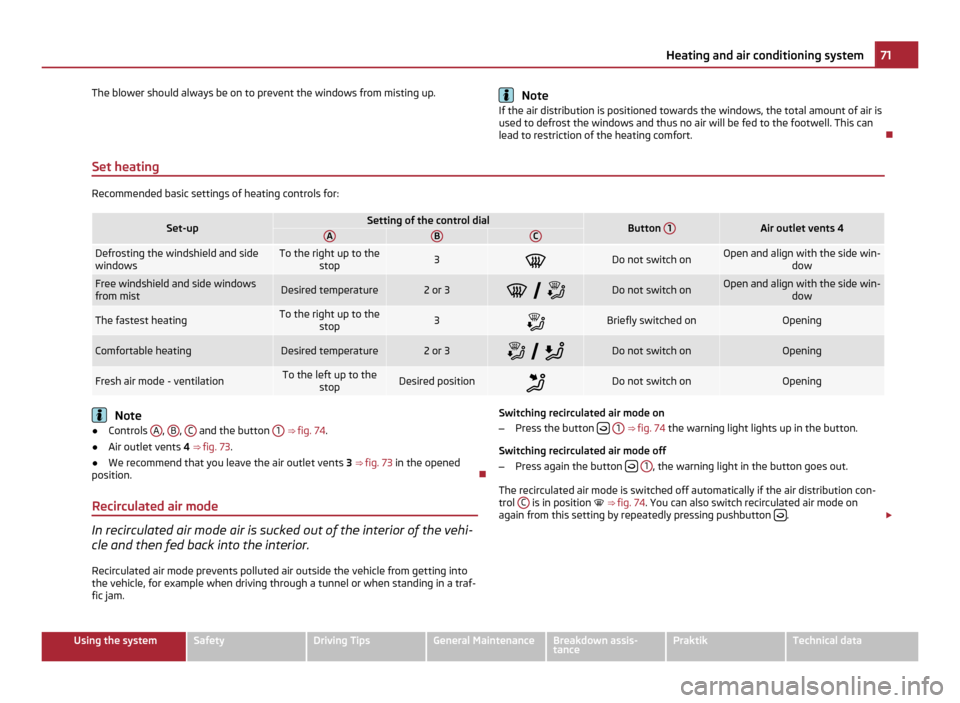
The blower should always be on to prevent the windows from misting up.
Note
If the air distribution is positioned towards the windows, the total amount of air is
used to defrost the windows and thus no air will be fed to the footwell. This can
lead to restriction of the heating comfort.
Set heating Recommended basic settings of heating controls for:
Set-up Setting of the control dial
Button
1 Air outlet vents 4
A B C
Defrosting the windshield and side
windows To the right up to the
stop 3
Do not switch on Open and align with the side win-
dowFree windshield and side windows
from mist
Desired temperature 2 or 3
Do not switch on Open and align with the side win-
dowThe fastest heating To the right up to the
stop 3
Briefly switched on Opening
Comfortable heating Desired temperature 2 or 3
Do not switch on Opening
Fresh air mode - ventilation To the left up to the
stop Desired position
Do not switch on Opening
Note
● Controls A ,
B ,
C and the button
1 ⇒ fig. 74.
● Air outlet vents 4 ⇒ fig. 73.
● We recommend that you leave the air outlet vents 3 ⇒ fig. 73 in the opened
position.
Recirculated air mode In recirculated air mode air is sucked out of the interior of the vehi-
cle and then fed back into the interior.
Recirculated air mode prevents polluted air outside the vehicle from getting into
the vehicle, for example when driving through a tunnel or when standing in a traf-
fic jam. Switching recirculated air mode on
– Press the button
1 ⇒ fig. 74 the warning light lights up in the button.
Switching recirculated air mode off
– Press again the button
1 , the warning light in the button goes out.
The recirculated air mode is switched off automatically if the air distribution con-
trol C is in position ⇒
fig. 74. You can also switch recirculated air mode on
again from this setting by repeatedly pressing pushbutton .
£ 71
Heating and air conditioning system Using the system Safety Driving Tips General Maintenance Breakdown assis-
tance Praktik Technical data
Page 75 of 212
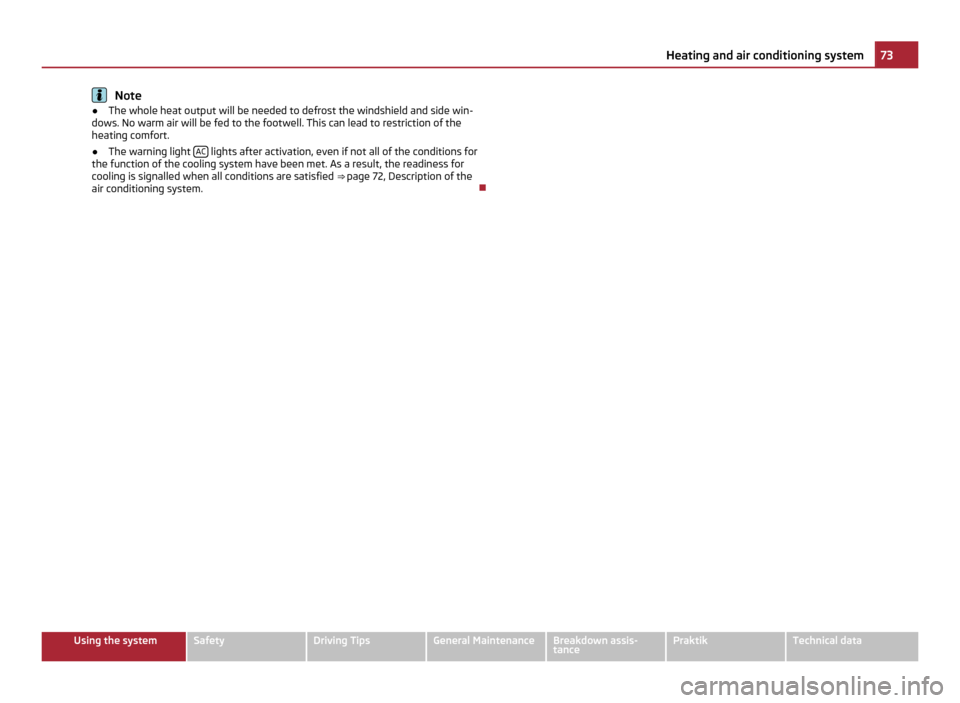
Note
● The whole heat output will be needed to defrost the windshield and side win-
dows. No warm air will be fed to the footwell. This can lead to restriction of the
heating comfort.
● The warning light AC lights after activation, even if not all of the conditions for
the function of the cooling system have been met. As a result, the readiness for
cooling is signalled when all conditions are satisfied ⇒
page 72, Description of the
air conditioning system. 73
Heating and air conditioning system Using the system Safety Driving Tips General Maintenance Breakdown assis-
tance Praktik Technical data
Page 77 of 212

The recirculated air mode is switched off automatically if the air distribution con-
trol
C is in position ⇒
fig. 75. You can also switch recirculated air mode on
again from this setting by repeatedly pressing pushbutton .
WARNING
You should not leave recirculated air mode on over a longer period of time, as
“stale
” air may result in fatigue in the driver and occupants, divert your atten-
tion and also cause the windows to mist up. The risk of having an accident in-
creases. Switch recirculated air mode off as soon as the windows begin mist-
ing up.
Climatronic (automatic air conditioning) Description The Climatronic system is an automatic heating, fresh air and cool-
ing system which provides optimal comfort for the occupants of the
car.
The Climatronic maintains a constant temperature fully automatically, once it has
been set. This is achieved by automatically varying the temperature of the out-
flowing air, the blower stages and the air distribution. The system also takes into
account sunlight which eliminates the need to alter the settings manually. The
automatic mode ⇒ page 76 ensures maximum well-being of the occupants at all
times of the year.
Description of Climatronic system
The cooling operates only if the following conditions are met:
● engine running,
● outside temperature above approx. +2 °C,
● AC switched on.
The AC compressor is switched off at a high coolant temperature in order to en-
sure cooling of the engine at high loads. Recommended setting for all periods of the year:
●
Set the desired temperature, we recommend 22 °C (72 °F).
● Press the button AUTO ⇒ fig. 76
.
● Move the air outlet vents 3 and 4 so that the air flow is directed slightly up-
wards.
Switching over between degrees Celsius and degrees Fahrenheit
Press and hold the buttons AUTO and
AC ⇒ fig. 76
at the same time. The informa-
tion in the desired temperature measuring unit appears in the display. Note
● We recommend that you have Climatronic cleaned by a specialist garage once
every year.
Overview of the control elements Fig. 76 Climatronic: Control elements
Buttons/control dial
Setting the interior temperature
The displays Display of selected inside temperature, e.g.: +22
°C (72 °F)
Degrees Celsius or Fahrenheit
Automatic air conditioning mode
De-mist or de-ice the windshield £
1 2
3
4
5 75
Heating and air conditioning system Using the system Safety Driving Tips General Maintenance Breakdown assis-
tance Praktik Technical data
Page 79 of 212
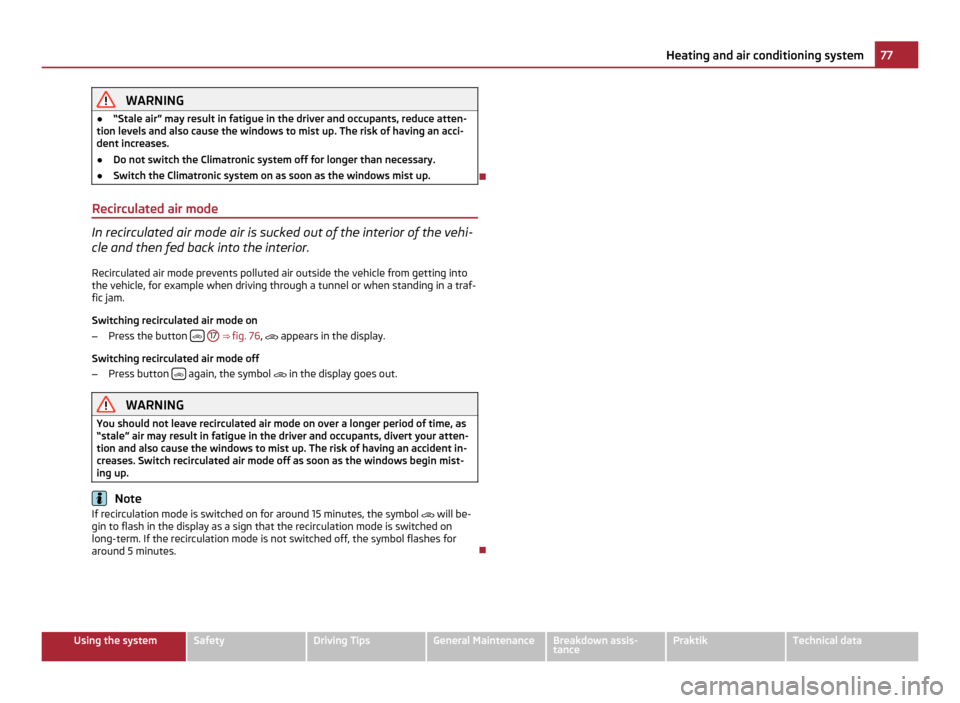
WARNING
● “Stale air ” may result in fatigue in the driver and occupants, reduce atten-
tion levels and also cause the windows to mist up. The risk of having an acci-
dent increases.
● Do not switch the Climatronic system off for longer than necessary.
● Switch the Climatronic system on as soon as the windows mist up.
Recirculated air mode In recirculated air mode air is sucked out of the interior of the vehi-
cle and then fed back into the interior.
Recirculated air mode prevents polluted air outside the vehicle from getting into
the vehicle, for example when driving through a tunnel or when standing in a traf-
fic jam.
Switching recirculated air mode on
– Press the button
17
⇒ fig. 76
, appears in the display.
Switching recirculated air mode off
– Press button again, the symbol
in the display goes out. WARNING
You should not leave recirculated air mode on over a longer period of time, as
“stale
” air may result in fatigue in the driver and occupants, divert your atten-
tion and also cause the windows to mist up. The risk of having an accident in-
creases. Switch recirculated air mode off as soon as the windows begin mist-
ing up. Note
If recirculation mode is switched on for around 15 minutes, the symbol will be-
gin to flash in the display as a sign that the recirculation mode is switched on
long-term. If the recirculation mode is not switched off, the symbol flashes for
around 5 minutes. 77
Heating and air conditioning system Using the system Safety Driving Tips General Maintenance Breakdown assis-
tance Praktik Technical data